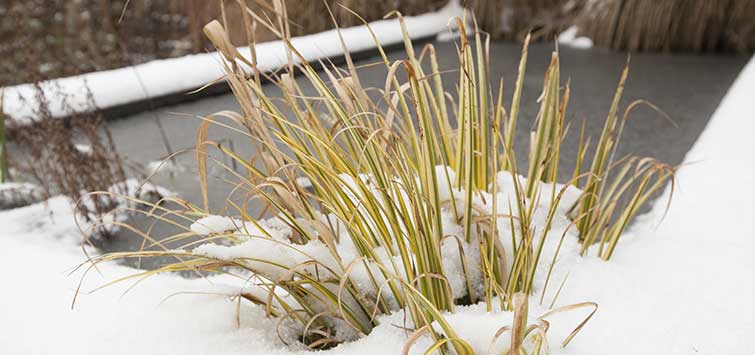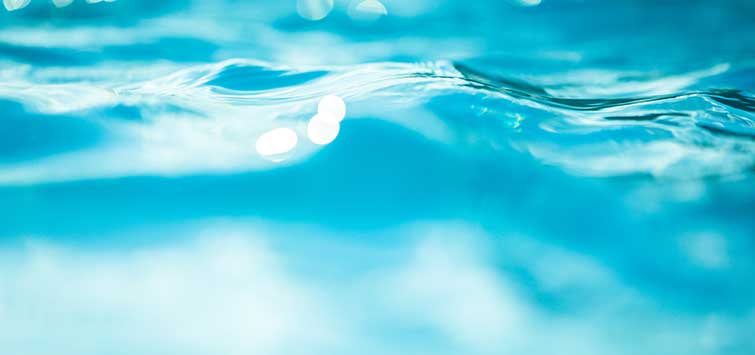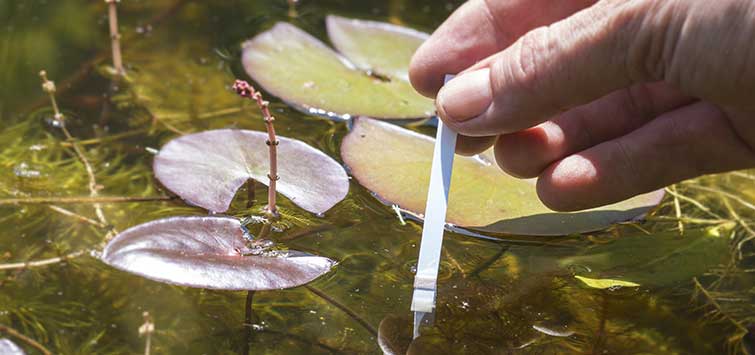The Skeptical Fishkeeper: Prepping Your Pond for Winter
Author: Laura Muha
About six years ago my husband and I installed a small goldfish pond in our backyard. We enjoyed it all summer, and then, as cold weather approached, we paid a visit to the pond shop to see what we had to do to winterize it.
“There’s nothing to it,” the clerk told us. “When the water temperature dips below 50 degrees, stop feeding the fish, unplug the filter, and forget you even have a pond till spring. Oh, and you might want to add a floating deicer so the fish get oxygen.”
“Wow, that’s easy!” we thought, and proceeded to follow her advice to the letter.
Our Blunder
It was, I regret to say, a big mistake. Before the winter was out, every fish in our pond had died, and I had no idea why. The only thing that was clear was that ignoring the pond all winter probably wasn’t the way to go. But what was? I decided that before I restocked the pond, I had to figure out what went wrong and what I needed to do differently the next time so that any future fish of mine would live to see another summer.
Dr. Tepper
Enter Dr. Julius Tepper, a Long Island fish veterinarian and interim Executive Director of the newly formed Aquatic Veterinary Association. This non-profit professional organization promotes the advancement of aquatic medicine worldwide, and one of its missions is educating hobbyists like, well, me. So early last spring, Tepper brought me along on a series of pond calls during which he advised clients on what they needed to do to get their ponds in shape for the warm weather. The information I gathered that day was the subject of my March and April columns earlier this year.
Now, with cold weather approaching, Tepper told me he’d be revisiting one of the ponds we’d seen in the spring, to help the owner prep it for winter. Did I want to come along? The answer, obviously, was yes.
So on an unseasonably warm fall day, Tepper and I met in the driveway of a beige two-story house owned by Long Island pondkeeper David Schiffman. The last time I’d been there, the trees at the perimeter of Schiffman’s property were just starting to bud, but now the orange tinge of their leaves served as a reminder that winter was right around the corner. Schiffman’s 13,000-gallon pond, however, was even more gorgeous than it had been during my previous visit; back then, the weather hadn’t warmed up enough for plants, but now the pond was lush with grasses and water lilies soaking up the last bit of Indian-summer sun.
Beneath the Surface
As Tepper points out, though, appearances can be deceiving when it comes to a pond; beneath the surface (so to speak) of even the most beautiful ponds a lot of invisible things can be going on, and by the time they become obvious, you have a disaster on your hands. So at least twice a year—preferably during the transitional periods of spring and fall when ponds are least stable—it’s important to do a preventative checkup, looking closely at three things: the fish, the water quality, and the system as a whole. That way, if anything’s amiss, you’ll catch it before it leads to a cascade of problems, he said.
Some Feeding Advice
Tepper started his visit with a visual inspection of Schiffman’s goldfish and koi. They were all active and generally looked good, although he said he would prefer them to be a bit heavier than they were.
“Are you still feeding them?” he asked Schiffman.
“Before work and after work, but I’m cutting back now,” Schiffman said. “They’re getting only the winter food, and I think at the end of the week I’ll lay off altogether.”
“When you feed them, does everything get sucked up [by the fish]?” Tepper asked.
“Definitely!” Schiffman said.
“Then I would stay with two times a day,” Tepper advised. “Stay with the low-protein food, but don’t back off [feeding them] till they slow up on their eating on their own.”
He explained that it’s important to pay extra attention to their diet heading into fall, especially if the pond is located in a colder climate, since the fish will spend the winter months in a state of semi-dormancy in which they’ll eat very little. What they’re eating now will have to tide them over for as long as four or five months. However, that doesn’t mean you should feed them heavily, he said; rather, feed small amounts frequently and make sure the fish are eating it all. At this time of year it’s unlikely you’ll be able to fatten them up, but you don’t want them to lose any more weight, either, Tepper said.
Making the Switch
It’s also important to switch to a lower-protein food as the weather starts to get colder, he continued, since a fish’s metabolism declines along with the water temperature, and as a result food moves much more slowly through its digestive tract. Foods with high protein content can sit in a fish’s gut and rot there if the water is cold enough.
The question, of course, is when to make the switch to lower-protein foods, and when to stop feeding altogether. The conventional wisdom is to switch to a low-protein food and begin tapering off feeding when the water temperature drops below 60°F, and to stop altogether when it hits 50°F and stays there. But, Tepper said, you can also take your cues from your fish; most will naturally show less interest in food as their metabolism declines, and it often becomes apparent when to stop.
Health and Water Quality Checks
The next step of Tepper’s exam was to pull one of Schiffman’s goldfish out of the water and anesthetize it so he could perform a skin scrape; he also clipped samples of its fins and gills and checked them under the microscope for parasites and other pathogens. This is something most of us laymen won’t be able to do on our own, but if you can locate one of the growing numbers of veterinarians who treat fish, a parasite check is a preventive measure well worth doing once a year, preferably in spring or fall, Tepper said. That’s because some parasites remain active at lower temperatures, but fish become less able to fend them off because their immune systems are suppressed in colder water. (Some pondkeepers salt their water at this time of year as a preventive measure—indeed, I’ve talked to vets who recommend it—but Tepper said he isn’t a fan of doing so.)
Water Quality Checkup
Schiffman’s fish didn’t show any signs of parasites or other pathogens, so Tepper returned it to the pond and moved on to the next stage of his checkup: water quality. Obviously, keeping an eye on temperature, pH, ammonia, nitrites, and nitrates is a good idea at any time of year, Tepper said, but it’s especially important as cold weather approaches, since you want water quality to be tiptop as fishes’ slowing metabolisms leave them more vulnerable to problems.
Speaking from personal experience, owners of small ponds might want to check them a few times during the winter, too, especially if there’s a lot of precipitation. The normal pH of rain ranges from about 5.6 to a low of around 4, and if there’s a lot of it—as there is during the winter in my part of the country—it can cause the pH in small ponds to drop, something I learned the hard way. The winter after my fish died, but before I restocked, I tested the pH in my 500-gallon pond and was stunned to discover that it had dropped from its normal 8.0 to somewhere around 5, and the buffering capacity was so low that it didn’t register on the test strip—a factor that obviously must have contributed to the fishes’ demise. Every winter since then I’ve tested regularly and added small amounts of baking soda to raise the pH when necessary (it’s been fairly often).
Getting Through the Winter
What I was most curious about during my pond call with Tepper was what system-wide recommendations he’d make for over-wintering the fish. For years, most people have done exactly what the clerk in my pond shop advised me to do: simply shut down the filters, fountains, and waterfalls and ignore the ponds till spring. The rationale is that you don’t need filtration because your fish aren’t going to be eating, and therefore won’t be producing much waste. And you don’t need to aerate with waterfalls or fountains because cold water holds more oxygen than warm water. “I used to be a shutdown fan, too, because that was the least of all the evils you could do,” said Tepper, who is a koi hobbyist as well. “But we lost a lot of fish that way.”
That’s partly because the fish tend to cluster in one spot and, since the water isn’t circulating, so do their waste products, which they are producing even during the winter, albeit at a much slower rate than they are in warm weather.
Aeration Troubles
In addition, the fish most often congregate in the deepest portion of the pond, but gas exchange occurs at the surface, so if the water isn’t circulating, not much oxygen is making it to the bottom where the fish are clustered. Granted, the fish are using less oxygen because their metabolisms have slowed, and cold water also holds a lot more oxygen than warm water, but there will still be lower levels at the bottom than at the top—a potentially unhealthy scenario that can contribute to fish mortality and morbidity.
On the other hand, keeping the system running isn’t a good solution either—at least not in very cold climates. That’s because the more that the water moves, the greater the surface area that comes into contact with the air—and the more its temperature fluctuates. “If the air is hot [during the day] and you’re mixing water with air, you’re going to increase the water temperature,” Tepper said. “Then, at night, the air temperature drops and so does the water temperature.”
Tepper’s Advice
His recommendation: at temperatures below 60°F, you don’t need to aerate the water, so turn off the waterfall or valve it down to a trickle. Better yet, install a waterfall bypass by putting a T-valve in the line just before the waterfall. Then, run some flexible tubing from the valve back into the pond at the base of the waterfall, making sure the outflow tube is completely submerged. That way the water returning to the pond flows in under the surface and is not exposed to the air. It’s also critical to turn the flow rate down—way, way down, Tepper said. “You want to move the water, just not the way you move it in the summer,” he said.
In summer, most pond owners aim for about a two-hour turnover rate in their ponds—meaning that all the water in the pond passes through the filter once every two hours. In winter, however, once every 10 hours is about right, Tepper said.
An alternative to a waterfall bypass is to place a very small pump at the lowest point in the pond, and run a length of flexible tubing from there to the shallow end, once again making sure that the tubing is completely submerged. The pump water is drawn from the deep end where the fish tend to congregate, and propelled through the tubing to the shallow end; from there, it will gradually drift back down toward the deep end, thereby circulating the water ever so gently. “You shouldn’t see any real [water] movement except for a little ripple,” Tepper told Schiffman. “You want what I call ‘insensible’ movement.” Which will help to keep the pond and its occupants healthy until next spring.
See the full article on TFH Digital http://www.tfhdigital.com/tfh/200710/#pg64

.png?h=595&iar=0&w=2781&hash=5FD5E69473BCC22199FBFA2FB71B6033)



